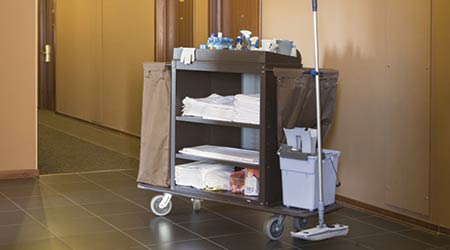
Keeping cleaning carts looking good while reducing the spread of bacteria
The housekeeping cart is an essential tool in a cleaner’s arsenal. These mobile janitorial closets not only provide adequate storage for the supplies needed to stock restrooms and other areas, but they also hold cleaning tools such as mops and microfiber cloths, chemical bottles, mop buckets, and trash and recycling bins.
Since cleaning carts are the most visible piece of equipment that building occupants see — they’re often in plain sight in hallways and doorways — custodial professionals are trained to keep them neat and orderly. A messy cleaning cart portrays a negative perception that not only extends to the custodian, the custodial department, and the cleaning itself, but also to the overall facility’s image.
“The appearance of carts is important in that it is one of the more conspicuous tools that represents a department,” says Scott Spencer, associate director of the Facilities Services Custodial Department at the University of Washington in Seattle. “It’s cleanliness and organization creates an immediate impression on building occupants as to the quality of work a cleaning operation is capable of delivering.”
On the flip side, a dirty cleaning cart can be a cross-contamination risk for a facility. Because they are mobile, cleaning carts can be a breeding ground for bacteria, carrying microorganisms from one room to the next — and in healthcare facilities, they have the potential to be the carriers of superbugs.
“Think of the irony. You’re bringing a cleaning cart into an environment or room to clean it, and the cleaning cart may be making the environment dirty just by being there,” says Keith Schneringer, director of channel marketing and sustainability for WAXIE Sanitary Supply, a jan/san distributor based in San Diego. “Whether it is stuff on the wheels or it’s a mechanism for transferring dirt. It becomes a vehicle for contamination.”
Cleaning Of Carts Gets Overlooked

 The Down and Dirty on Cleaning in Virus Season
The Down and Dirty on Cleaning in Virus Season How Surfactant Use is Expanding in Commercial Cleaning
How Surfactant Use is Expanding in Commercial Cleaning Maximize Your Margins: Learn How to Automate Pricing and Track Rebates
Maximize Your Margins: Learn How to Automate Pricing and Track Rebates